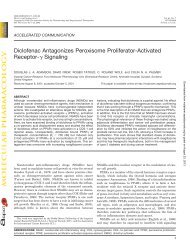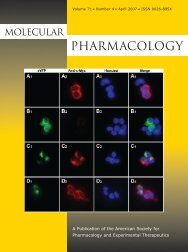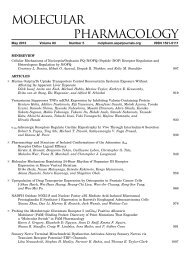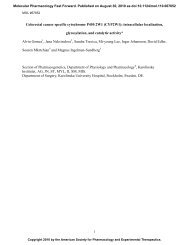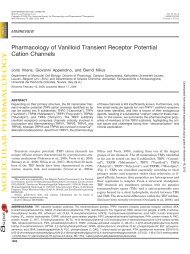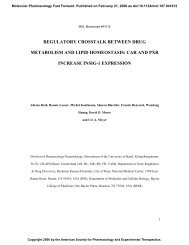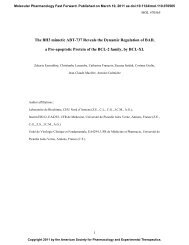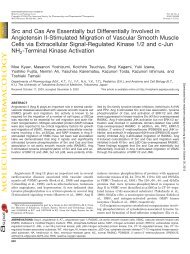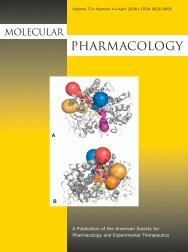Full Pharmacological Efficacy of a Novel S1P1 Agonist That Does ...
Full Pharmacological Efficacy of a Novel S1P1 Agonist That Does ...
Full Pharmacological Efficacy of a Novel S1P1 Agonist That Does ...
You also want an ePaper? Increase the reach of your titles
YUMPU automatically turns print PDFs into web optimized ePapers that Google loves.
acting as a potent agonist on S1P 1, 3–5 subtypes. Discovery<br />
<strong>of</strong> SEW2871 (Sanna et al., 2004), a selective agonist for<br />
S1P 1 that replicated the lymphopenic actions <strong>of</strong> FTY720,<br />
plus development <strong>of</strong> selective S1P 1 antagonists with in<br />
vivo activity, later demonstrated that S1P 1 was the primary<br />
mediator <strong>of</strong> lymphocyte sequestration in secondary<br />
lymphoid organs and lymphopenia.<br />
Mechanistic insights into S1P 1-mediated lymphopenia came<br />
from combining genetics, pharmacological tools, and two-photon<br />
imaging (Wei et al., 2005; Sanna et al., 2006). The last <strong>of</strong><br />
these has allowed studying real-time lymphocyte dynamics in<br />
the intact lymph node, where SEW2871 infusion reduces lymphocyte<br />
egress in the medulla, whereas a selective S1P 1 antagonist<br />
(W146) fully reverses agonist actions.<br />
In the thymus, S1P 1 agonism enhances late thymocyte<br />
maturation yet inhibits subsequent thymocyte egress (Rosen<br />
et al., 2003; Alfonso et al., 2006; Weinreich and Hogquist,<br />
2008). Consequently, S1P agonist administration reduces naive<br />
blood CD4 � and CD8 � thymocytes and B cells by nearly<br />
90 and 70%, respectively.<br />
Regulation <strong>of</strong> lymphocyte trafficking with S1P 1 agonists<br />
has opened the possibility for clinical modulation <strong>of</strong> lymphocyte<br />
dynamics, exemplified by the positive results reported in<br />
multiple sclerosis (MS) clinical trials with FTY720 (Hiestand<br />
Fig. 1. Chemical structure <strong>of</strong> ligands used in this study.<br />
S1P 1 Agonism <strong>Efficacy</strong> without Headgroup Interactions 1309<br />
et al., 2008). Although the mechanism <strong>of</strong> FTY720 in ameliorating<br />
MS symptoms is not clear, it may encompass multiple<br />
targets, both systemic (including S1P 1-mediated lymphopenia)<br />
and local, by actions on neurons (Kataoka et al., 2005;<br />
Balatoni et al., 2007; Miron et al., 2008). Vascular integrity <strong>of</strong><br />
the blood-brain barrier (BBB) is likely to participate in the<br />
mechanism <strong>of</strong> FTY720’s efficacy in MS (Foster et al., 2008).<br />
Thus, understanding the contribution <strong>of</strong> systemic and local<br />
effects <strong>of</strong> S1P 1 modulation would be relevant for developing<br />
efficacious therapies for autoimmune disease.<br />
Previous studies aimed at dissecting the S1P-S1P 1 binding<br />
pocket have provided strong evidence for a model <strong>of</strong> S1P<br />
ligand interaction with three charged residues on S1P 1 (Parrill<br />
et al., 2000; Wang et al., 2001). Two residues, Arg 120 and<br />
Glu 121 , which are present on TM3 <strong>of</strong> all S1P receptors, interact<br />
with the phosphate headgroup and the ammonium moiety<br />
<strong>of</strong> S1P, respectively. The importance <strong>of</strong> Arg 120 and Glu 121<br />
interactions with S1P has been demonstrated by mutagenesis.<br />
Substitution <strong>of</strong> Arg 120 or Glu 121 with alanine results in<br />
total loss <strong>of</strong> [ 33 P]S1P binding to S1P 1 and, consistent with<br />
the lack <strong>of</strong> binding, neither <strong>of</strong> the TM3 mutants internalizes<br />
after an S1P challenge or stimulates S1P-mediated<br />
guanosine 5�-O-(�-[ 35 S]thio)triphosphate binding. Thus,<br />
the strong zwitterionic nature <strong>of</strong> S1P requires hydrophilic<br />
Downloaded from<br />
molpharm.aspetjournals.org by guest on December 14, 2012




